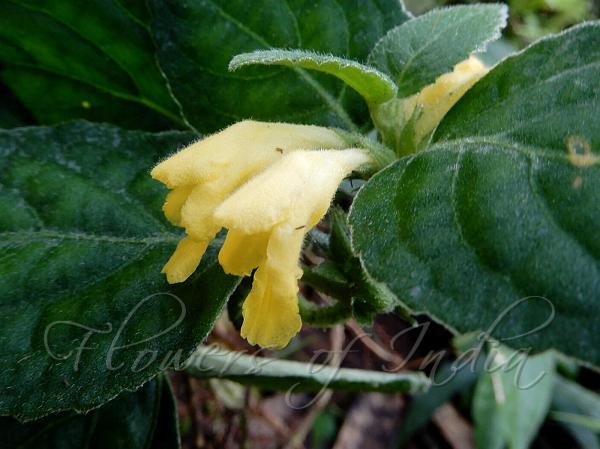|
| East-Himalayan Horn-Flower |
|

|

| File size | 323462 |
| Original date | 7/1/25 3:22 PM |
| Resolution | 1400 x 1050 |
| Flash | Flash did not fire, auto |
| Focal length | 4.3mm |
| Exposure time | 1/30s |
| Aperture | 3.4 |
| Focus Distance | |
| Metering Mode | Multi-segment |
| Camera make | NIKON |
| Camera model | COOLPIX A900 |
| Sensor type |
|
|
|
|
Photo: |
Botanical name: Gomphostemma ovatum Family: Lamiaceae (Mint family)
Synonyms: Gomphostemma ovatum var. flaccidum
Synonyms: Gomphostemma ovatum var. flaccidum
East-Himalayan Horn-Flower is an evergreen perennial
herb, with fibrous root system, rootstock, tuber like rhizome. Flowers
are borne in leaf axil, 3 to many flowers, 2-5 cm long. Flowers are
with fused petals, yellow, 2-4.7 cm, sparsely finely velvet-hairy
outside, hairless inside. Flowers are two-lipped, upper lip 7 mm long,
9.5 mm wide, lower lip 1.1 cm long 1.3 cm wide. Flower-tube is 1-1.8 cm
long, 4 epipetalous stamens 3.4-3.6 cm long and 1 stigma 3.6 cm long.
Sepal-cup is gamosepalous, pale green, 5 lobed, 1-1.5 cm, sparsely
hairy. Flowers are born in opposite cyme, subtended by bracts, easily
indistinguishable from leaves. Bracts are leaf like small cluster,
subtending cyme, involucral bracts, star-shaped hairs, large bracteole
exceed the sepal-cup. Stem is four-edged, 15-150 cm tall, whole stem is
covered with star-shaped hairs, prostrate or some are erect with roots
at the nodes. Leaves are opposite, stalked, leaf blade up to 8-10 cm,
leaf margin is sawtoothed with tip pointed, unbranded hair with
multicellular base on the upper leaf surface and below star-shaped
hairs are present. East-Himalayan East-Himalayan Horn-Flower is found
in East Himalaya, from Nepal to NE India.
| Identification credit: Tabish | Photographed at Krang Suri Waterfall, Meghalaya. |
• Is this flower misidentified? If yes,